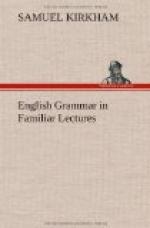The relative is not varied on account of gender, person, or number, like a personal pronoun. When we use a personal pronoun, in speaking of a man, we say he, and of a woman, she; in speaking of one person or thing, we use a singular pronoun, of more than one, a plural, and so on; but there is no such variation of the relative. Who, in the first of the preceding examples, relates to an antecedent of the mas. gend. third pers. sing.; in the second, the antecedent is of the fem. gend.; in the third, it is of the second pers.; and in the fourth, it is of the first pers. plur. num.; and, yet, the relative is in the same form in each example. Hence you perceive, that the relative has no peculiar form to denote its gend. pers. and num., but it always agrees with its antecedent in sense. Thus, when I say, The man who writes, who is mas. gend. and sing.; but when I say, The ladies who write, who is feminine, and plural. In order to ascertain the gend. pers. and num. of the relative, you must always look at its antecedent.
WHO, WHICH, and THAT.
Who is applied to persons, which to things and brutes; as, “He is a friend who is faithful in adversity; The bird which sung so sweetly, is flown; This is the tree which produces no fruit.”
That is often used as a relative, to prevent the too frequent repetition of who and which. It is applied both to persons and things; as, “He that acts wisely, deserves praise; Modesty is a quality that highly adorns a woman.”
NOTES.
1. Who should never
be applied to animals. The following
application of it is erroneous:—“He
is like a least of prey,
who destroys without
pity.” It should be, that destroys,
&c.
2. Who should not be
applied to children. It is incorrect to say,
“The child whom
we have just seen,” &c. It should be, “The
child
that we have just seen.”
3. Which may be applied
to persons when we wish to distinguish one
person of two, or a particular
person among a number of others; as,
“Which of the
two? Which of them is he?”
4. That, in preference to who or which, is applied to persons when they are qualified by an adjective in the superlative degree, or by the pronominal adjective same; as, “Charles XII., king of Sweden, was one of the greatest madmen that the world ever saw;—He is the same man that we saw before.”
5. That is employed
after the interrogative who, in cases like
the following; “Who
that has any sense of religion, would have
argued thus?”
When the word ever or soever is annexed to a relative pronoun, the combination is called a compound pronoun; as, whoever or whosoever, whichever or whichsoever, whatever or whatsoever.




